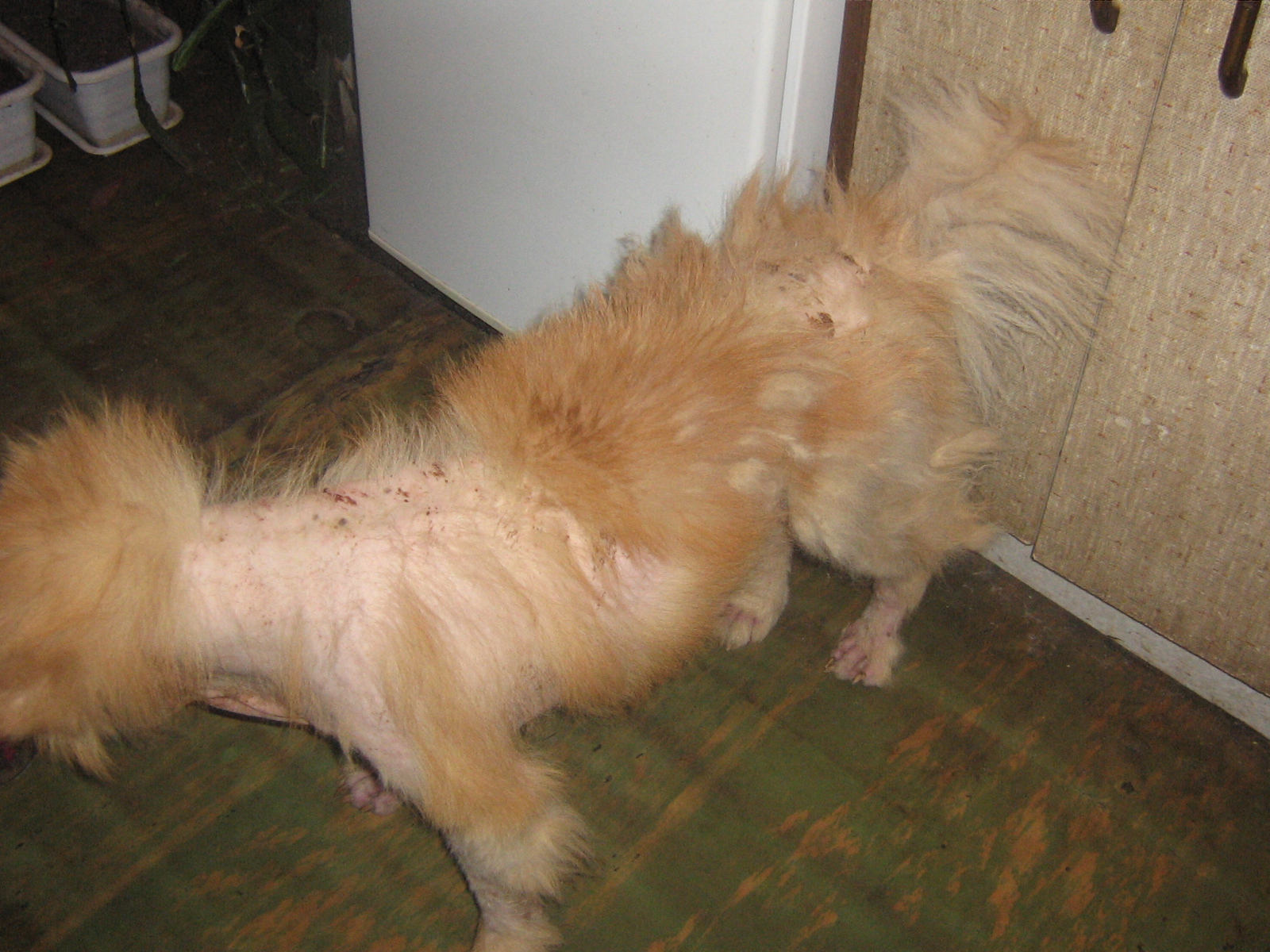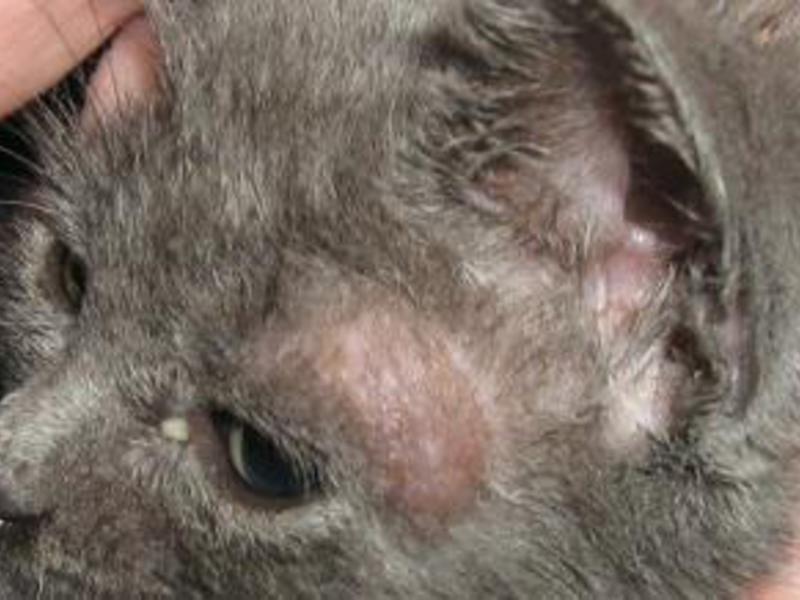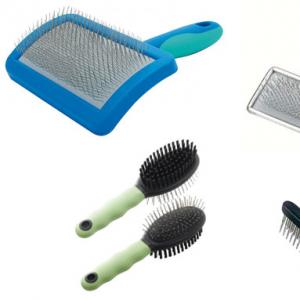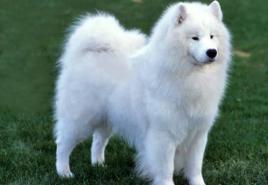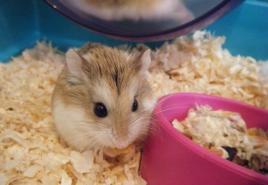Ringworm in cats: initial stage symptoms and treatment
Ringworm is a fairly common and dangerous skin disease caused by two types of fungi. The first causes trichophytosis, the second - microsporia. The disease affects the skin of not only animals, but also people with weakened immune systems.
Ringworm: description of the disease, symptoms
Ringworm spreads easily and very difficult to treat. Fungal spores are very tenacious and can survive on various surfaces for a long time. It is believed that only stray animals suffer from ringworm, but this is not true - the disease is also not uncommon for pets. Infection mainly occurs from rodents or through contact with stray cats on the street.
The causative agent of cat lichen is resistant to disinfectants and detergents. The risk of contracting lichen is greater for starving, sick cats with weak immune defenses, as well as animals affected by worms.
Symptoms of ringworm in cats
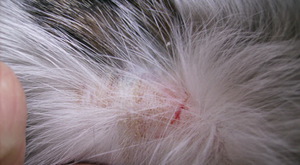 The onset of the disease may indicate small rashes on the skin. However, they are very difficult to detect under the animal's thick fur, so the initial stage of the disease usually goes unnoticed. But still, upon careful examination, you can notice the appearance of a small spot of bare skin, on which pustules and scales are visible. In some cases, itching is observed.
The onset of the disease may indicate small rashes on the skin. However, they are very difficult to detect under the animal's thick fur, so the initial stage of the disease usually goes unnoticed. But still, upon careful examination, you can notice the appearance of a small spot of bare skin, on which pustules and scales are visible. In some cases, itching is observed.
The incubation period of the disease can last from 7 days to three months, depending on the strength of the cat’s immunity.
Symptoms may include:
- the cat's fur becomes crumpled and greasy;
- Fungal infections are observed on the claws.
- deformation of the claws and their abnormal growth occurs;
- hair loss in affected areas;
- the appearance of dandruff.
In an advanced form of the disease, the cat sleeps a lot, refuses to eat, shows almost no activity and does not respond to its name. Gradually, the area of infection expands and fungal spores invade new areas of the body. The head, tail and neck are most often affected.
In order to start treatment for such a dangerous disease in time, you need to know exactly what ringworm looks like in cats. If you have a sick cat in your apartment, then it’s better for him define a special place, where he will eat and spend most of his time. You should not bathe an animal in a shared bathroom or allow it into the kitchen or rooms, because lichen is very contagious and can easily pass to a person, especially a small child. Limit your pet's movements around the house until its final recovery.
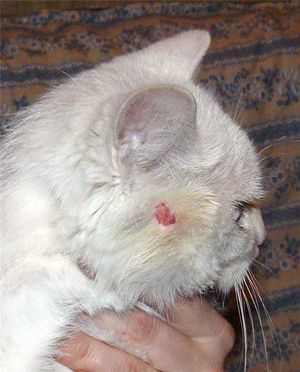 The symptoms of some diseases are very similar to lichen (for example, the vital activity of the lice eater). Therefore, before starting treatment, it is necessary to make an accurate diagnosis. The presence (or absence) of this disease can be determined by a Wood's lamp emitting ultraviolet light. If lichen is really present, then under the influence of rays the skin on the affected area will be illuminated in bright green.
The symptoms of some diseases are very similar to lichen (for example, the vital activity of the lice eater). Therefore, before starting treatment, it is necessary to make an accurate diagnosis. The presence (or absence) of this disease can be determined by a Wood's lamp emitting ultraviolet light. If lichen is really present, then under the influence of rays the skin on the affected area will be illuminated in bright green.
However, this method has its disadvantages:
- some types of microorganisms, like lichen, can fluoresce;
- Not every type of lichen fungus can produce this reaction.
For a more accurate diagnosis from the affected area of the body a scraping is taken. The sample is placed in a vessel with a special medium; if the result is positive, after 5 - 6 days a colony of spores (a white lump) appears in the flask. To confirm the diagnosis, studies are performed using a microscope.
Feline ringworm: photo
Many people wonder: what does lichen in cats look like?
Ringworm in cats is a group of small round spots, on which the fur has completely fallen out. Over time, the spots become larger and their sizes increase. Fungal spores, having affected one area of the skin, quickly spread, increasing the area of infection and the severity of the disease. The skin at the site of the lesion and near it resembles dandruff.
Particular attention should be paid to the treatment of the disease in the area of the animal’s head and muzzle, since the lesion can spread to the mucous membranes, for example, the eyes, which leads to blindness.
Types of lichen in cats
Ringworm is mainly caused by the following types of fungus:
- Microcporum canis;
- Microcporum gypseum;
- Trichphyton.
All these types are practically no different from each other and therefore have similar symptoms.
Treatment of ringworm in cats
The method of treatment when a pet is infected with lichen is determined by several factors. The degree of body resistance, the number and size of affected areas, as well as the phase of development of the disease are taken into account.
Vaccines
In the initial stages, lichen can be cured using special drugs:
- Polivac;
- microderm;
- vacderm F.
Vaccination of domestic cats is carried out 2-3 times with an interval of two weeks. These same injections are recommended for preventive purposes when there is a threat of cat infection. For example, if there are several cats in the house and one of them definitely has shingles. In order to strengthen the cat's immunity, drugs such as Fosprenil and Ribotan are used.
Ointments
If the initial phase of infection has passed unnoticed and the disease has spread throughout almost the entire body of the cat, the use of ointments is inevitable. In this case, the doctor may prescribe one of the following medications:
- Sanoderm;
- YAM BK ointment;
- Fungin.
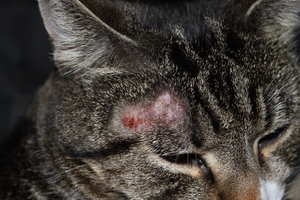 Each of these drugs has an antifungal effect and is able to eliminate the causative agent of the disease.
Each of these drugs has an antifungal effect and is able to eliminate the causative agent of the disease.
Treatment of affected areas with fungin should be carried out with a cotton swab once a day. The course of treatment is two weeks.
YAM BC is applied twice a day for 10 days, that is, until crusts begin to separate from the affected areas and hair growth resumes.
Has also worked well Sanoderm ointment, the course of therapy is up to one month. Initially, the drug is used twice a day until the condition of the skin improves; in the future, the use of the drug can be reduced to once a day.
In addition to the above medications, Miconazole and Thiabendazole can be used.
Lime sulfur baths are quite effective.
If the disease is not very advanced, ringworm in cats can be cured on your own at home. However, before using oral medications, you should consult a specialist, as most of them have side effects.
Preparations for internal use
Particularly complex cases of the disease require additional treatment with oral medications. These may be the following situations:
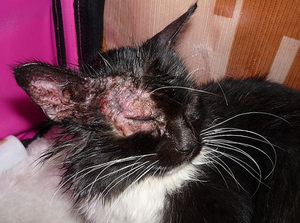
Among oral medications, one can note the special antifungal antibiotic Griseofulvin, which suppresses inflammation and promotes rapid tissue regeneration. Complex treatment (griseofulvin + ointment) enhances the effectiveness of the drug. However, this medicine has side effects in the form of possible anemia(anemia), therefore, before consuming griseofulvin, it is necessary to test the blood for platelets. Particular attention should be paid to the therapy of pregnant animals.
The synthetic antifungal drug Ketoconazole, used twice a day, also performed well. The dosage is determined by the size of the pet and is calculated in the ratio of 5-10 mg/kg. live weight. It is possible to use ketoconazole once a day, but subject to doubling the single dose. Side effects are anorexia and diarrhea.
Itraconazole is another drug that is used to control ringworm in cats. Unlike ketoconazole, this drug has a milder effect. The dosage is determined at the rate of 10 mg/kg. live weight.
So, ringworm is very dangerous and contagious disease, from which not only your pets can suffer, but also you yourself and your family members. Therefore, it is easier to prevent the disease by observing the necessary precautions, and if infection does occur, you should immediately contact a specialist and begin treatment without bringing the disease to its extreme stages.
